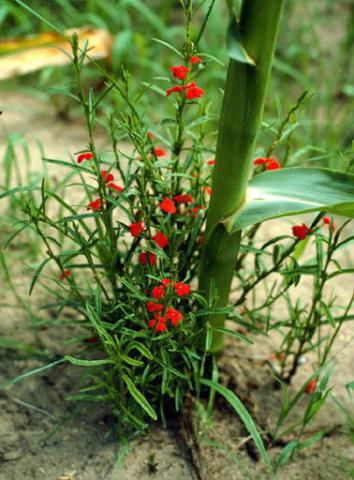Vampires, witchweeds and the Strigolactones
Strigolactones are a class of carotenoid derived compounds. As the most recently described class of plant hormones they are reported to play an ever expanding role in plant development. As a plant hormone, they act like signaling molecules which communicate with other plant hormone systems including auxins, cytokininins and ABA. Equally significant is their role in promoting symbiotic relationships between plants and soil microbes, a key aspect of plant’s mineral nutrition. Interestingly, name “Strigolactone” is derived from this latter role. Strigolactones in the root exudates of crops such as maize induce seed germination of the parasitic plant Striga (witchweed). Striga is known to destroy entire crops of subsistence farmers in Africa, (and also sugarcane, maize and sorghum crops in the US). Despite the devastation that is caused by attracting its namesake, the parasitic and pretty flowered Striga (for those NextGen botanists, Striga itself is named after a mythical vampire!), the positive potential of strigolactone in subsidizing plant’s phosphate nutrition is predicted to be as far reaching, and paralleled to that of modified gibberellin action in the green revolution (see Steven M. Smith in Nature 19 Dec 2013).
Strigolactone biosynthesis is the featured pathway in our latest release of the Plant Reactome. Biosynthesis of strigolactones proceeds via isomerization and cleavage of beta carotene. The rice strigolactone biosynthetic mutant D27 show a dwarf but high tillering phenotype; and the rice cultivar Bala of the indica subspecies which is reported to have two of its MAX 1-like genes deleted also has a high tillering phenotype (Cardosa et al: PNAS 14 Jan 2014). These altered phenotypes are attributed to the effects of strigolactones (SLs) on the efflux of auxin. In Arabidopsis, an additional dimension to the role of SLs in the physiology of plants is indicated by the up-regulation of the SL biosynthetic enzymes CCD7 and CCD8 in response to drought, salt and ABA, implicating SLs in modulating plant’s response to abiotic challenges (Ha et al. PNAS 30 Dec 2013)
We are just starting to understand the growing list of functionalities of this newly described plant hormone. In a future release we will extend the Strigolactone biosynthetic pathway in Plant Reactome to its perception and signaling. So, stay tuned!

Striga (witchweed) parasitizing a maize plant. Source: http://www.parasiticplants.siu.edu/Orobanchaceae/images/Striga.asia2.JPEG
- vindya's blog
- Log in to post comments
